
2024 National Regulatory Reform Progress Rankings Report
Issue Areas
Related Content
Acknowledgment: Prior to his departure to join the Virginia Office of Regulatory Management, Regulatory Policy Manager Matthew Nolan dedicated countless hours to developing the methodology and research for this report. The authors are grateful for his critical efforts.
Introduction
Federal, state, and local regulations impose burdens on businesses and citizens based on multiple justifications including harm reduction, fairness, or safety. However, many regulations fail to provide the benefits their authors anticipate while at the same time foisting expensive fees and complicated paperwork, reporting, and business requirements on employers and innovators. Though businesses bear the initial brunt of regulations, costs quickly shift to customers who ultimately pay higher prices, employees who face pay cuts and layoffs, and investors who endure financial losses. Meanwhile, innovators are discouraged against their entrepreneurial aspirations.
Onerous, outdated state regulations, or those issued without statutory authority, undermine human flourishing by imposing excessive compliance burdens and costs on businesses and citizens. Worse, these regulations undermine constitutional checks and balances between the branches of government, affording quasi-legislative powers to unelected bureaucrats. This regulatory inertia—an ever-growing state-level regulatory compliance burden—requires an equal and opposite force: bold leaders armed with smart laws.1
These smart laws take shape in effective administrative procedures that hold unelected agency bureaucrats accountable to the public, ensure sound and transparent regulatory processes, and foster an administrative culture of intellectual humility that regularly reviews all rules and regulations for relevance and efficacy.
Those concerned with regulatory inertia should think beyond the toll of individual regulations and instead pursue procedural reforms to solve overregulation upstream. Regulatory procedures should be oriented by three guiding principles: accountability, review, and transparency.
- Accountability ensures that bureaucrats who impose regulations answer to the public and are required to defend their rules as valid and worthwhile exercises of government power. Accountability also requires agencies to carefully evaluate the costs and benefits of rules to ensure the benefits outweigh the burdens while avoiding harm.
- Review allows citizens to challenge onerous and procedurally noncompliant rules and regulations, prevents courts from automatically assuming that agencies are acting in the best interests of the public, prohibits agencies from enforcing unwritten or non-public rules, and places the burden of explaining the legal basis of rules back on those who made them.
- Transparency gives average citizens, small business owners, grass-roots activists, and others access to participate in the full regulatory process without filing complicated Freedom of Information Act (FOIA) requests or hiring expensive lawyers.
These principles inform the Cicero Institute’s suite of regulatory policies. Specifically, Cicero advocates for policies such as automatic rule expiration after 5- or 10-year time horizons, rigorous cost-benefit analysis during the promulgation of all rules, independent executive-branch oversight of regulatory agencies by bodies accountable to the governor, and court venue freedom that allow those affected by burdensome regulations to challenge them in local courts.2,3,4,5 These measures, among others, ensure that regulations serve the public interest and support the success of dynamic markets.
Absent rigorous and accountable regulatory procedures, state-level agencies are emboldened to promulgate unnecessary and burdensome rules that stymie market efficiency and undermine human potential. State-level regulations contain 416 million words and impose, on average, 138,000 regulatory restrictions per state.6–7 Restrictive language tends to disproportionately hurt small businesses and startups, entities that lack the resources and connections to navigate compliance.8 The regulatory burden is not confined to any particular political alignment: red and blue states alike struggle with regulatory inertia. Texas, traditionally red, ranks among the most heavily regulated alongside blue states such as New York, California, and Illinois.
The goal of this report is to inform policymakers and stakeholders about the current condition of regulatory procedures in their states and to offer actionable recommendations and insights to foster more efficient and accountable regulatory procedures. By addressing regulatory inertia and implementing robust review processes, states can improve market health and human outcomes.
This report evaluates state-level regulatory environments based on criteria designed to enhance accountability, transparency, and reviewability. Five hundred data points from 10 criteria across the law codes of all 50 states were examined to provide a comprehensive national ranking. This 50-state analysis highlights states leading the regulatory reform movement as well as clear pathways for other states to implement reforms.
Relevant Recent Studies
Mercatus 2024 – Snapshots of State Regulation9
The Mercatus Center’s 2024 “Snapshots of State Regulations” provides a detailed analysis of the economic impact of regulatory accumulation. The study highlights that excessive state-or province-level regulations contribute to poorer economic conditions by increasing poverty rates, destroying jobs, and raising prices. For example, British Columbia’s experience shows that cutting regulations by nearly 40 percent resulted in a one percentage point increase in its economic growth rate.10 This study underpins the necessity of regulatory reforms, aligning with Cicero policies such as automatic sunsets and regulatory budgets, which aim to systematically reduce regulatory burdens and improve economic conditions.
Manhattan Institute 2024 – Zero-Based Regulation11
The Manhattan Institute’s report “Zero-Based Regulation: A Step-by-Step Guide for States” examines the implementation of zero-based regulation in Idaho. It demonstrates that by requiring agencies to start from scratch with their regulations every five years, Idaho was able to eliminate thousands of pages of unnecessary regulations, making it the least regulated state. This approach combines sunset provisions, regulatory budgets, impact analyses, and independent reviews. The success of Idaho’s model supports the efficacy of Cicero’s proposed reforms, emphasizing the importance of systematic regulatory review and the elimination of outdated rules to reduce regulatory burdens.
American Experiment 2024 – Policies to slow and shrink our state’s regulatory burden12
John Phelan’s article from American Experiment uses Minnesota as a case study to discuss the significant economic and political burdens imposed by state regulations. The state requires extensive education and fees for occupational licensing, which benefits those already licensed but harms consumers and potential new entrants, thereby reducing economic welfare. The article also emphasizes the growth of regulatory burdens over time. These findings lend credence to Cicero’s policy proposals by highlighting the need for reforms like cost-benefit analysis (CBA) requirements and independent reviews to ensure regulations provide are net beneficial and do not stifle economic activity.
KPMG 2023 – The ‘Empowerment’ of State Law and Regulation13
The goal of this report is to inform policymakers and stakeholders about the current condition of regulatory procedures in their states and to offer actionable recommendations and insights to foster more efficient and accountable regulatory procedures. By addressing regulatory inertia and implementing robust review processes, states can improve market health and human outcomes.
Methodology
This report reviews and analyzes the Administrative Procedure Acts (APAs) of each of the 50 states. It does not consider executive orders or the implementation of the laws; rather, it evaluates the statutory frameworks guiding regulatory procedures in each state. Further, even though many states made changes to their APA in 2024, this report focuses only on the APA as of January 1, 2024. Thus, any major reforms (such as those in Iowa or Louisiana) will not be reflected in this year’s report but will be scored in a new report that will be published mid-year in 2025.
Each state’s APA was assessed on a 10-point scale that measures key aspects of accountability, reviewability, and transparency as indicated by research. The scoring system is designed to enable clear and precise comparisons between states.
The data collection process involved:
- Reviewing State APAs: Each state’s APA was thoroughly examined to identify and measure statutory language relevant to each of Cicero Institute’s specific scoring criteria, explained in more detail in the next section.
- Scoring: Points were awarded based on the extent to which each state’s APA met the established criteria. Partial points were awarded for provisions that partially fulfilled requirements. States had to explicitly meet the criteria to receive points.
The resulting scores were compiled into a binary database, which was then processed into numerical rankings. States with higher scores are ranked as having healthier regulatory procedures, though further research is needed to confirm this hypothesis.
This analysis was confined to state law codes and did not evaluate whether the states have effectively implemented statutes. Therefore, states with good procedures but poor implementation may experience suboptimal regulatory outcomes not reflected in this report; alternatively, states with bad procedures but effective governors may outperform those with poor procedures.
Variable Scoring and Criteria
In this report, aggregated data were categorized into four main areas to enable state-by-state scoring. The scoring criteria were designed to analyze the health of each state’s regulatory procedures and provide actionable pathways for reform. This offers policymakers concise and comprehensive scores and recommendations for their states. Each category has its own sub-scoring methodology, which is then aggregated into a composite state score.
This year, a systematized scoring methodology was used to ensure that each of the 50 individual state APAs was held up against the same measuring stick. Data was obtained from Alaska—absent from last year’s report—to provide a complete national analysis. The awarding of partial points was also systematized to ensure a more nuanced analysis across each criterion. Finally, a thorough rationale section was included and cited the specific statutory language of each awarded point to ensure scoring accuracy. After implementing these changes and reviewing statutory changes from 2023, state scores increased an average of 0.58 points.
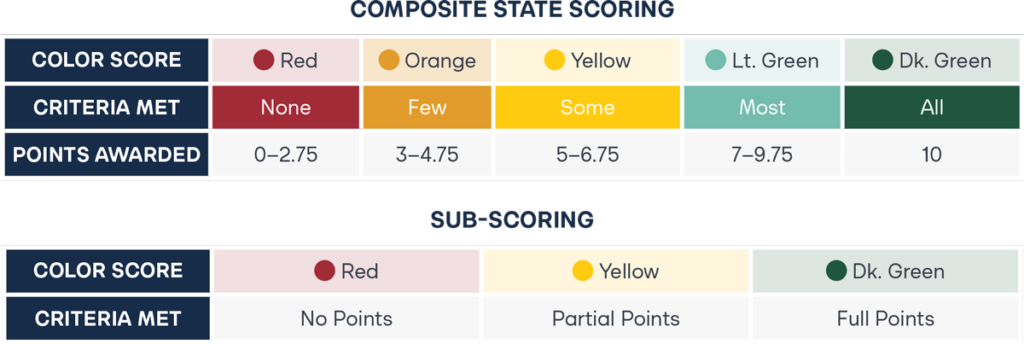
4.1 Sunset Provisions
Sunset provisions ensure that regulations automatically expire on rigid timelines, enabling the removal of outdated or conflicting rules and refreshing the regulatory landscape. Comprehensive requirements are crucial for effective rulemaking, yet all but three states (Utah, New Hampshire, Indiana, and Tennessee) lack such provisions. Sunsets should automatically expire regulations, require equal or greater justification for renewal, and include a thorough review of each rule’s efficacy across its lifespan. States can receive up to three points across the following metrics:
Sunset Law for All Regulations (+1):
Points Awarded: 0-1
- 0 points: No sunset law.
- 0.5 points: A sunset law either applying to some regulations or a standardized expiration timeline that is not binding.
- 1 point: A sunset law applying to all regulations with a standardized expiration timeline.
Points Awarded: 0-1
- 0 points: No re-approval requirement.
- 0.5 points: Re-approval required but lacks clear standards.
- 1 point: Re-approval required with equal or greater justification.
Points Awarded: 0-1
- 0 points: No required lookback/review system.
- 0.5 points: Lookback/review required but not comprehensive.
- 1 point: Comprehensive required lookback/review for all regulations/agencies.
4.2 Cost-Benefit Analysis
Cost-benefit analysis (CBA) compares the expected benefits of a regulation against its costs, ensuring that the benefits outweigh the costs. States often lack exhaustive CBA requirements or fail to define clear metrics. Effective CBAs consider economic impacts, are data-driven, transparent, and accessible to the public. States can receive up to three points across the following metrics:
Citizen Challenge on CBA Grounds (+0.5):
Points Awarded: 0-0.5
- 0 points: No provision for public challenge.
- 0.25 points: Public can provide feedback during rule-making but lack clear standing to challenge regulations on the basis of inept CBAs.
- 0.5 points: Citizens can challenge regulations based solely on the basis of bad CBAs.
CBA Required for Implementation (+1):
Points Awarded: 0-1
- 0 points: No CBA requirement.
- 0.5 points: Evidence considered without standardized CBA procedure.
- 1 point: Standardized CBA with a thorough review of costs and benefits.
CBA Required for Renewal (+0.5):
Points Awarded: 0-0.5
- 0 points: No CBA requirement for renewal.
- 0.25 points: Weak CBA requirement for renewal.
- 0.5 points: Strong CBA requirement for renewal.
Publicly Available, Transparent, and Data-Driven CBA (+1):
Points Awarded: 0-1
- 0 points: Not publicly available or data-driven.
- 0.5 points: Either publicly available or data-driven.
- 1 point: Both publicly available and data-driven.
4.3 Office of Information and Regulatory Affairs-style Independent Review
Office of Information and Regulatory Affairs-style (OIRA) independent review enhances accountability in rulemaking. States often lack independent review mechanisms, relying solely on agencies to ensure their own rules meet the legal and policy requirements of the statute and state administrative procedure laws. All regulations ought to be reviewed and approved by the governor’s office or an office in another part of the executive branch (such as the attorney general’s office). Effective independent review agencies should have the authority to compel regulatory adjustments. States can receive up to two points across the following metrics:
Independent Review Board (+2):
Points Awarded: 0-2 0 points: No independent review board
- 1 point: Either a review board exists but is limited in scope or authority, or cost-imposing regulations require legislative approval.
- 2 points: Review board with full authority comparable to OIRA is in place.
4.4 Venue Restrictions
When a citizen believes he is improperly regulated, or when he believes that a regulation was not legally created, that citizen should be able to challenge the regulation in the same court where they might be charged for violating the rule—but most states restrict where citizens can challenge regulations.
These venue restrictions deter challenges against onerous rules and favor powerful incumbent firms that can afford expensive travel, disadvantaging entrepreneurs and innovators. Effective regulatory procedures should ease these restrictions, allowing challenges in convenient locations such as the plaintiff’s county of residence or primary place of business.
States can receive up to two points by fulfilling the following metrics:
No Venue Restriction (+2):
Points Awarded: 0-2
- 0 points: Restrictive venue requirements.
- 1 point: Accommodations such as online venues or local court hearings.
- 2 points: No venue restrictions, allowing challenges in local courts.
Results
This data collection culminates in the annual rankings, where states are ranked against one another based on total points earned. The states that ranked in the top ten all demonstrate exemplary regulatory procedures in their statutes. These top states were strong across all metrics but were stronger in some criteria than others. Among the top 10, only Utah and Tennessee earned full points for sunsets. Kentucky, New Jersey, and Arizona earned full points for CBA. Connecticut, Arkansas, Wisconsin, Arizona, and Colorado earned full points for independent review. And each of the top ten states, except New Jersey, earned full points for venue freedom.
While every state earned points, no state earned a perfect score for all criteria. The average score for all states was just over half the total available points at 5.425 out of a possible 10. States earned on average 1.23 out of 3 points for sunsets, 1.665 out of 3 points for CBAs, 1.27 out of 2 points for independent review, and 1.26 out of 2 points for venue freedom.
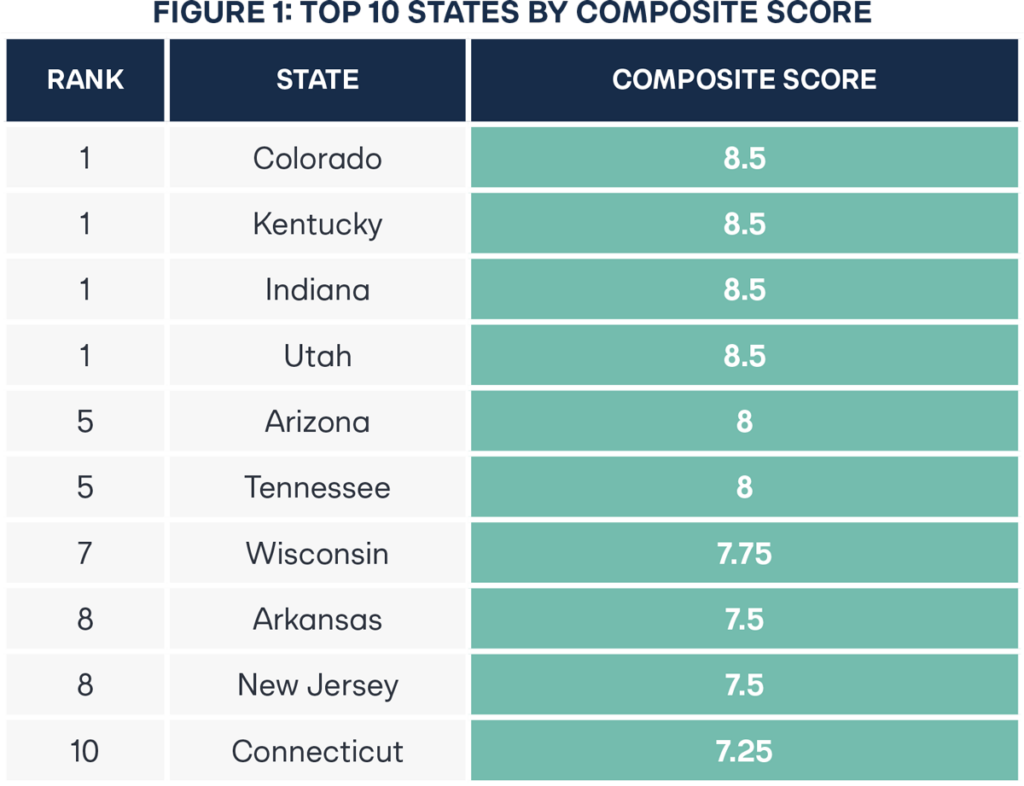

5.1: Sunset Provisions
Many states earned partial points for sunset provisions with partial expiration or periodic review requirements but failed to meet the full criteria for automatic expiration.
Category 1.A assessed whether a state has a sunset law applying to all regulations with a pre-set, standardized timeline for expiration. Only five states—Kentucky, Utah, Indiana, Tennessee, and New Hampshire—achieved full points, representing a mere 10 percent of all states. This indicates that the vast majority of states lack a comprehensive approach to ensuring regulations automatically expire unless actively renewed, which could potentially lead to outdated or unnecessary regulations remaining in effect.
In Category 1.B, points were awarded if regulations are required to be re-approved with a burden of justification equal to or greater than when they were first introduced to remain in effect post-sunset. Six states, or 12 percent, earned full points—Colorado, Utah, Indiana, Tennessee, New Hampshire, and North Carolina. The limited adoption of this provision suggests that many states do not enforce strict re-approval criteria, allowing regulations to persist without adequate contemporary justification.
Category 1.C, which mandates a required lookback or review for regulations and agencies, saw a notably higher compliance rate, with 48 states, or 96 percent, earning full points. Widespread adherence suggests that most states recognize the value of periodically reviewing regulations to ensure their relevance and efficiency.
However, when examining overall performance across all three categories, only four states—Utah, Indiana, Tennessee, and New Hampshire—achieved full points, representing just eight percent of all states. While many states may meet individual criteria, the comprehensive application of all three sunset law principles remains rare.
Furthermore, only 16 states, or 32 percent, earned at least half points (1.5 out of 3). Conversely, 34 states, or 68 percent, earned fewer than half of the possible points, underscoring a general deficiency in robust sunset law frameworks across the majority of states. Notably, five states—Nebraska, Hawaii, Louisiana, Georgia, and Pennsylvania—earned zero points, indicating a complete absence of the evaluated regulatory practices.
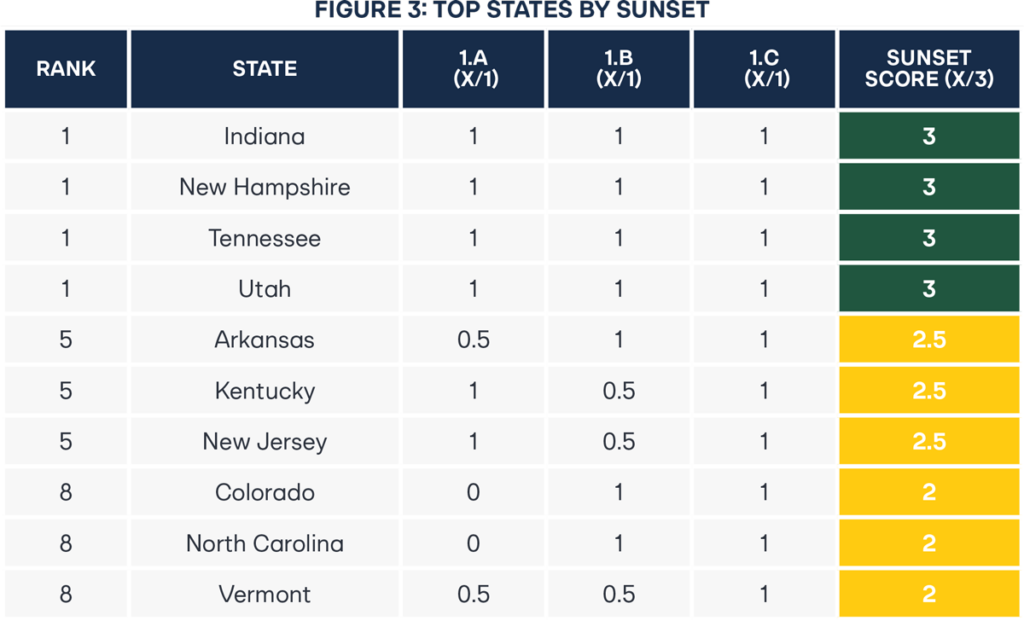
5.2: Cost-Benefit Analysis Requirements
Many states earned partial points for cost-benefit analysis (CBA) provisions, particularly those involving transparency and public availability, but failed to meet the full criteria for a comprehensive CBA framework.
In Category 2.A, which assesses whether citizens can challenge a rule if the cost-benefit analysis is inaccurate, fails to account for costs, overstates benefits, or otherwise does not weigh the costs and benefits, only nine states—Kentucky, Arizona, New Jersey, Utah, Florida, Missouri, Wisconsin, Idaho, and Tennessee—achieved full points, representing 18 percent of all states. This indicates that the majority of states lack mechanisms allowing citizens to challenge regulations, which can undermine public accountability and trust in the regulatory process.
In Category 2.B, which awards points if the rule is required to pass a cost-benefit analysis for implementation, a higher compliance rate is observed. Forty states, or 80 percent, earned full points. This widespread adherence suggests that most states recognize the importance of evaluating the costs and benefits before implementing new regulations, ensuring that the benefits justify the regulatory costs.
In Category 2.C, which mandates a cost-benefit analysis for rule renewals, saw lower compliance. Only seven states—Kentucky, Arizona, New Jersey, Colorado, Utah, Indiana, and New Hampshire—earned full points, representing 14 percent of all states. This indicates that most states do not require periodic reevaluation of regulations, which could lead to the persistence of outdated or ineffective rules.
Category 2.D assesses whether the cost-benefit analysis is publicly available, transparent, and data-driven. This category has a higher compliance rate, with 45 states, or 90 percent, earning full points. This suggests that most states value transparency and public access to regulatory information, enhancing the accountability and legitimacy of the regulatory process.
When examining the overall performance across all four categories, only three states—Kentucky, Arizona, and New Jersey—achieved full points, representing just six percent of all states. This highlights the rarity of a comprehensive approach to cost-benefit analysis in state regulations.
Furthermore, 19 states, or 38 percent, earned at least half points (1.5 out of 3). Conversely, 31 states, or 62 percent, earned fewer than half of the possible points, underscoring a general deficiency in robust cost-benefit analysis frameworks across the majority of states. Notably, two states—New Mexico and Pennsylvania—earned zero points, indicating a complete absence of the evaluated cost-benefit analysis practices.
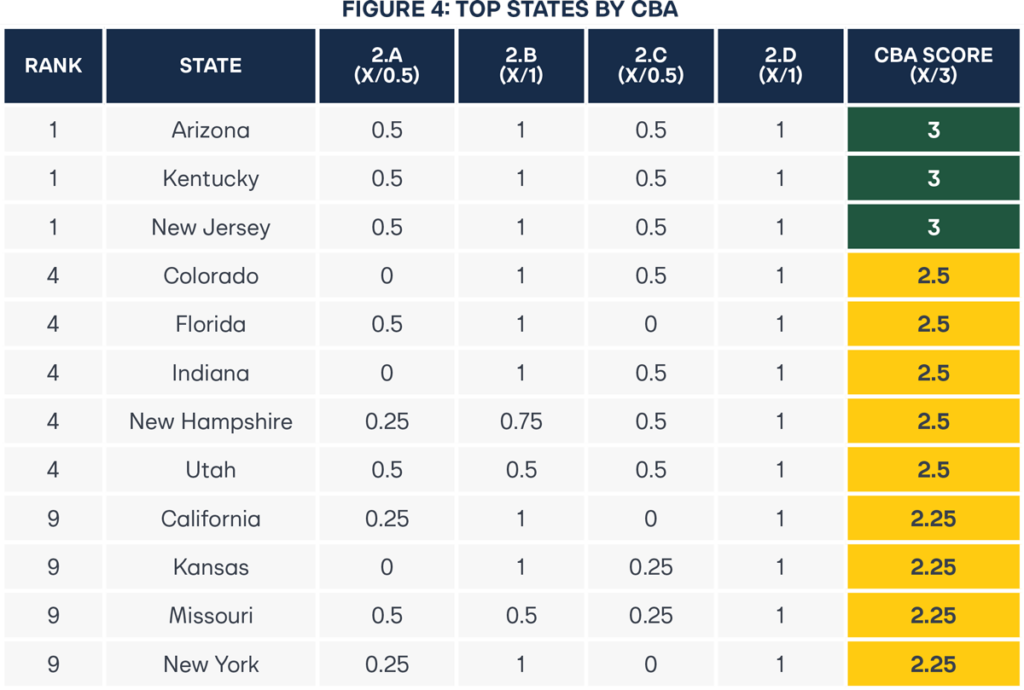
5.3: Independent Review
The analysis of independent review requirements for state regulations reveals a varied landscape, with a significant number of states partially meeting the criteria.
In Category 3.A, which examines the presence of an independent review board with significant authority comparable to the federal Office of Information and Regulatory Affairs (OIRA), 15 states, or 30 percent, achieved full points.
In Category 3.B, which assesses whether legislative approval is required for regulations imposing societal costs, and Category 3.C, which evaluates the presence of a limited review board, states could earn points in either category. In Category 3.B, 10 states, or 20 percent, earned full points.
Meanwhile, in Category 3.C, 23 states, or 46 percent, earned full points. Thus, while fewer states enforce stringent legislative oversight (3.B), a larger number recognize the value of some form of regulatory review board, even if limited in scope (3.C).
Overall, only 15 states earned full points. In contrast, 48 states earned at least half points, showing partial progress toward meaningful independent review. Only two states, Louisiana and Massachusetts, earned less than one point, with Massachusetts earning zero points.
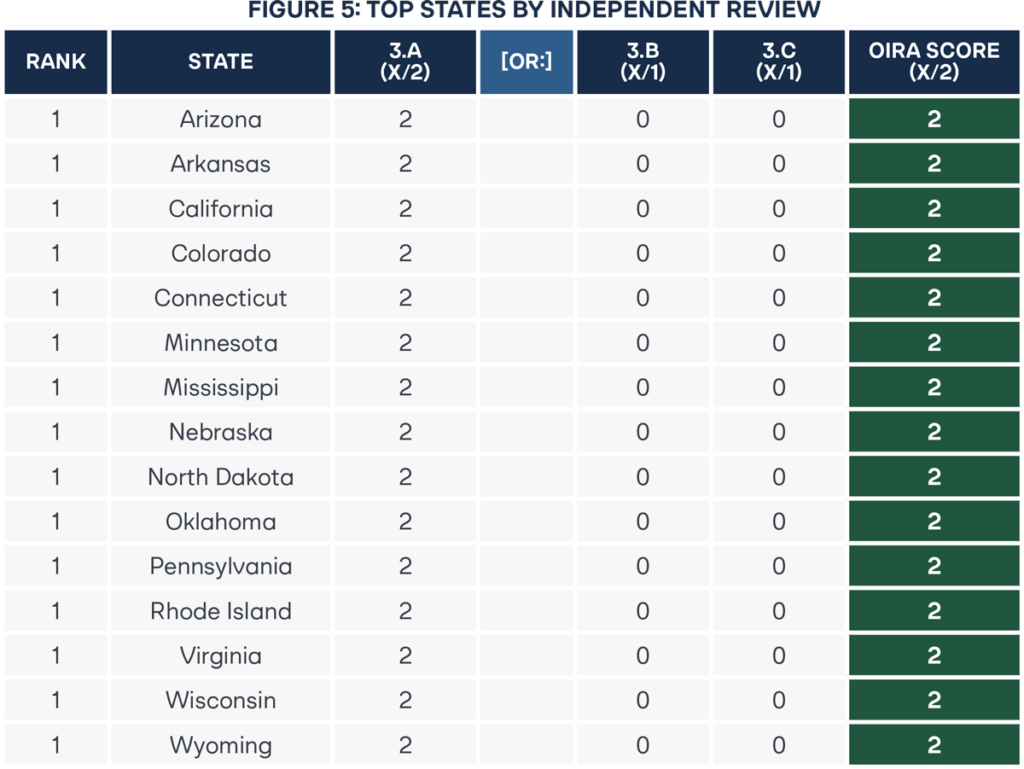
5.4: Venue Freedom
The analysis of states’ venue restriction policies reveals a significant divide between those that do not impose venue restrictions and those that do, with or without reasonable accommodation exceptions.
In Category 4.A, which assesses whether a state has venue restrictions, 29 states achieved full points, representing 58 percent of all states. This indicates that a majority of states allow unrestricted venues, supporting flexibility and accessibility in legal and administrative proceedings.
In Category 4.B, which evaluates whether a state has venue restrictions but provides reasonable accommodations, such as allowing online venues, five states—New Jersey, New York, Rhode Island, North Carolina, and Hawaii—earned full points, representing 10 percent of all states. This suggests that while these states impose some restrictions, they also recognize the need for practical exceptions to enhance accessibility.
However, 16 states—New Hampshire, California, Vermont, North Dakota, West Virginia, South Carolina, Oklahoma, Texas, Illinois, Delaware, Alabama, Nebraska, Louisiana, New Mexico, Georgia, and Pennsylvania—earned no points. This indicates strict venue restrictions without accommodations, which can potentially limit accessibility and flexibility in legal and administrative processes.
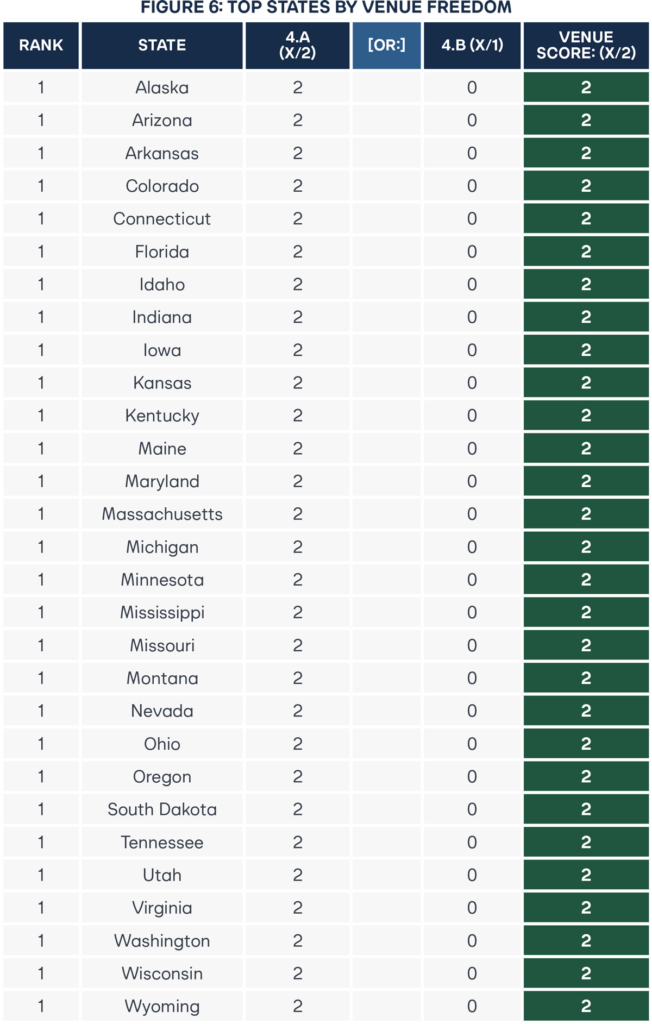
5.5: Overall Rankings
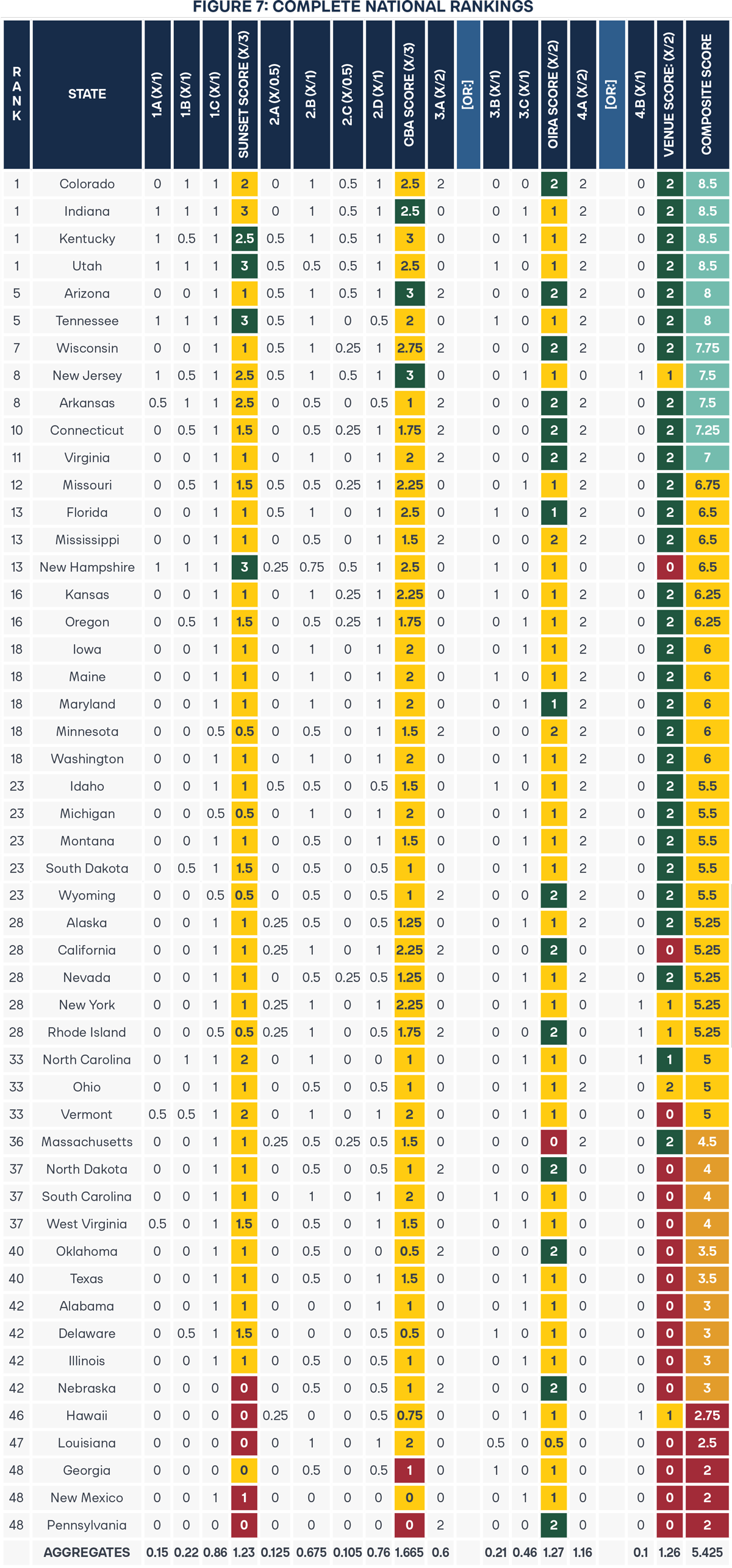
5.6: Case Studies
This section provides detailed case studies of regulatory reforms across various states, highlighting their progress, challenges, and recommendations for future improvements. It will examine the efforts of executive branch leaders, the 2024-year standout states, and specific examples from Arizona and Missouri.
5.6.1: Executive Branch Regulatory Leaders
In recent years, Virginia, Idaho, and Montana have championed ambitious regulatory reform, primarily through executive orders. These initiatives play a pivotal role in streamlining regulations and reducing bureaucratic burdens, creating a more efficient regulatory system and a more business-friendly economic climate. However, for these executive branch reforms to leave a lasting impact, it is essential that executive orders be codified into law.
Virginia’s (ranked 11th) Executive Order 19, issued on June 30, 2022, which focuses on the development and review of state agency regulations.14 Additionally, Executive Order 6, issued on January 14, 2022, aims to reinvigorate job growth by removing burdensome regulations from the business community.15 These orders set a strong example for bold executive branch leadership in regulatory reform.
Similarly, Idaho (T-23rd) implemented significant reforms through Executive Orders 01 and 13 in 2020. Executive Order 01, “Zero-Based Regulation,” requires state agencies to justify existing regulations through a so-called “zero-based” process aimed at eliminating needless and costly rules.16 Executive order 13,“Regulatory Relief to Support Economic Recovery,” went further, mandating that state agencies permanently remove regulations that were waived during the COVID-19 pandemic.17 Both executive orders, among other reforms, establish Idaho as a regulatory leader and contribute to the state’s regulatory efficiency and economic strength.
Montana (T-23rd) is also an executive branch regulatory leader due to its Red Tape Relief Advisory Council. Executive Order No. 1, issued on January 5, 2021, called upon this new council to identify and eliminate excessive, outdated, and unnecessary regulations, encouraging citizens to submit their own ideas for regulatory reduction through an online public “Red Tape Relief Form.”18 Montana’s bold efforts continued with Executive Order No. 17, issued on December 28, 2021, which emphasizes rule deletion to nurture economic growth, business expansion, and job creation.19
While governors in these states should be applauded for their bold use of executive orders to nurture better economies, even the most ambitious executive branch regulatory reforms can be undone with the swipe of a pen by future regulatory administrations. Thus, before leaders such as governors Youngkin, Little, and Gianforte leave office, they should endeavor to codify their bold reforms into law, ensuring permanent procedural improvements. Codification is crucial to provide stability and continuity, safeguarding progress made and enabling future administrations to build upon important achievements. As such, the Cicero Institute strongly recommends that state legislatures and governors take the necessary steps to enshrine these reforms in legislation.
5.6.2: 2024 Regulatory Leaders
Louisiana and Iowa emerged as key players in the realm of regulatory reform during the 2024 legislative session, enacting both statutes and executive orders to augment regulatory procedures. These recent efforts, however, are not reflected in the current rankings, which only account for statutes in place on January 1, 2024.
Louisiana (ranked 47th), passed several laws aimed at reducing onerous red tape. Governor Landry signed Senate Bill 60 which streamlines permit and licensing processes to reduce bureaucratic hurdles.20 Additionally, House Bill 716 introduced universal occupational licensing reciprocity, a significant step towards easing the mobility of professionals across state lines.21 Finally, Senate Bill 332 repealed the Occupational Licensing Review Commission, a move intended to simplify and improve the regulatory landscape.22
Iowa (T-18th) should also be commended for its regulatory reforms during the 2024 legislative session. Governor Kim Reynolds signed Senate File 2370 to limit judicial deference to agency legal interpretations.23 This statute, on top of Governor Reynolds’ Executive Order 10,—ordering a comprehensive evaluation of existing administrative rules to determine their necessity and effectiveness—recalibrates the balance of power between agencies, courts, and businesses in Iowa.
The regulatory reform initiatives undertaken this year in Louisiana and Iowa are commendable and reflect a strong commitment to market freedom and economic fairness. As these states continue to build on these reforms, they can look forward to ascending future rankings. As a next step, lawmakers in both states should codify the reforms proposed in this report.
5.6.3: Arizona (T-5th)
In 2024, Arizona made significant progress in regulatory reform by passing H.B. 2490, which removed venue restrictions, enhancing flexibility and accessibility in legal proceedings.24 This law cements Arizona as a leader in regulatory efficiency and accessibility.
However, Arizona’s journey toward comprehensive regulatory reform remains incomplete. Two critical bills, H.B. 2491 and S.B. 1343, were vetoed by the governor.25 H.B. 2491 aimed to reform the independent review process by enhancing the authority of the Government Regulatory Review Council (GRRC), while S.B. 1343 sought to implement automatic sunset provisions for outdated occupational licensing regulations.26 These reforms would have made Arizona’s regulatory environment even more efficient and accountable.
Arizona’s progress in venue freedom is commendable, but to fully realize its potential as a regulatory leader, Arizona lawmakers must revisit and pass both reforms that were vetoed, and should also introduce comprehensive sunsets. Successfully enacting these bills and introducing new procedural reforms, as outlined in this report, will solidify Arizona’s commitment to regulatory excellence and ensure lasting improvements that will benefit both businesses and citizens.
5.6.4: Missouri (12th)
In 2024, Missouri made notable strides in regulatory reform, particularly with the signing of S.B. 894 by Governor Mike Parson.27 This legislation establishes a “regulatory sandbox” designed to identify state regulations that can be waived or suspended for participating businesses. Over a two-year period, businesses with innovative offerings will benefit from reduced regulatory constraints, fostering an environment conducive to innovation and economic growth. Missouri’s innovating reform should be celebrated as a forward-thinking reform designed to support entrepreneurship.
However, Missouri’s efforts to implement a comprehensive cost-benefit analysis framework encountered setbacks. H.B. 2579, a bill that aimed to establish such a framework, died in committee.28 The proposed legislation would have ensured that the economic impacts of regulations are thoroughly evaluated, thereby promoting more informed and efficient regulatory decisions.
Additionally, to achieve a more robust and effective regulatory environment, Missouri must consider implementing automatic sunset provisions, as outlined in this report. Without automatic sunsets, Missouri will continue to suffer from regulatory accumulation, where outdated rules continue to impose unnecessary burdens on businesses and stifle innovation.
Conclusion
Each year, this report endeavors to a provide clear policy roadmap for state leaders interested in confronting and dismantling the regulatory inertia that crushes small businesses and constrains economic freedom in their states. By embracing policies that prioritize accountability, transparency, and regular review, states can break free from the shackles of outdated and burdensome regulations. This report provides policymakers with the necessary tools to strengthen their administrative procedures and foster a regulatory environment that supports innovation and economic growth.
2024 National Regulatory Reform Progress Rankings by State
Click on a state in the map below to see how it ranks in leading the regulatory reform movement.
